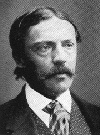Early years
He is born in 1828 in the provincial city of Jönköping, Sweden. The family (lower middle class) is dissolved when he is five, due to the death of his mother and the alcoholism of his father. His childhood and youth are plagued by poverty, but he still gets a fairly good education. The utopian liberalism of 1848 leaves a permanent mark on his political views.
1850s
From 1855 to 1876 he is a journalist at the liberal Göteborgs handels- och sjöfartsstidning ("Gothenburg Mercantile and Shipping Gazette"), then one of the leading newspapers in Scandinavia. Its owner/editor, S.A. Hedlund, becomes his close friend and manager.He also writes a number of novels, the most influential being Den siste athenaren of 1859, a neohellenistic work with high intellectual ambitions and a pungent anticlerical tendency. It is later published in the USA with considerable success (The Last Athenian, Philadelphia 1869).
1860s
Fame and notoriety came to Rydberg through Bibelns lära om Kristus (1862, "Christ According to the Bible"), a theological tract that denies the divinity of Christ with arguments from the New Testament. It made a large impact on Swedish society and engaged Rydberg in a long and bitter fight with the Church.There is no English translation, but Medeltidens magi of 1865 (The Magic of the Middle Ages, N.Y. 1879) gives a good picture of his views on organized religion at this time.

VR in 1871
1870s
After a long depression Rydberg reshapes his persona and emerges "reborn" from a journey to Rome. His essays and poems reach a wide audience; he gains general approval and climbs the social ladder. His romantic idealism is by now combined with classicist style and linguistic purism to a very personal blend.In 1876 he leaves journalism for academic teaching (philosophy and history of culture). Romerska Dagar (Roman days, N.Y. & London 1879), a collection of essays on classical history and art, is typical of this period.
1880s
While Swedish literature is dominated by the "modern" naturalistic movement, Rydberg withdraws to the study of germanic mythology. He discovers in the Old Norse myths the fragments of a vast epic of Homeric dimensions; he spends the decade trying to reconstruct it. His results (partly translated in Teutonic Mythology, N.Y.1889) are largely dismissed by other scholars as poetical imaginations.In 1884 he is appointed professor in Stockholm. His chair is History of culture, later History of art.
1890s
As the ascendancy of naturalism wanes, Rydberg returns to the literary scene. He is by now the most venerated writer in the country, being seen as a Teacher of the Nation and a kind of Supreme court in ethical questions.Shortly before his death he publishes the 4th and final version of his most intimately personal work, the romantic novel Singoalla (1857-94, english translations N.Y. 1903 and London 1904).
Apoteosis
Afterwards, his reputation continues to grow for some decades, along with the publication of popular editions and collected works, scholarly studies and biographies. Inescapably he is transformed into a national cultural icon, elevated on a marble pedestal.And then, from about 1930 onwards, he is gradually relegated to oblivion. The demise of Idealistic philosophy - the heart of Rydberg's thinking - is one explanation. Another is the increasingly unfashionable "sexlessness" of his writings - probably resulting from the repression of homoerotic desires.
Rydberg on the international scene
Most of his works were translated into Danish, Finnish, English and German, several into Dutch and French, occasional titles into other languages. The most widely spread is the childrens' book Little Vigg's Christmas Eve, with editions in at least 15 countries.In the last decade there has been a renewed interest in Rydberg's mythological works in the United States, with both new translations and reprints of older ones appearing on the market.
After a century
By now most of his works are obsolete, being too closely tied up with the intellectual environment of the 19th century. What does still remain a living part of the Swedish literature?Perhaps Singoalla, the story of Little Vigg, some poetry (especially the mighty political poem Den nya Grottesången, "The new song of Grotte"), and a mythical figure that has become part of the Swedish Christmas - The Tomten.
Further reading
Very little has been written about Rydberg in English. The best treatment is probably still that ofAlrik Gustafson: A history of swedish literature, Minneapolis 1961.
There is also an introductory essay on Rydberg in Judith Moffett's anthology of Swedish poetry (The North! To the North! : five Swedish poets of the nineteenth century, Southern Illinois Univ. Press, 2001).